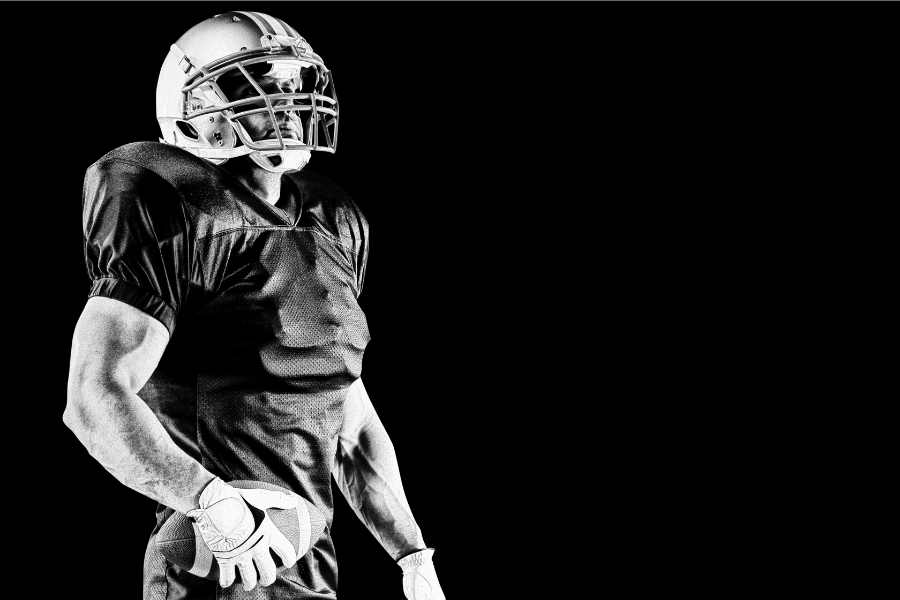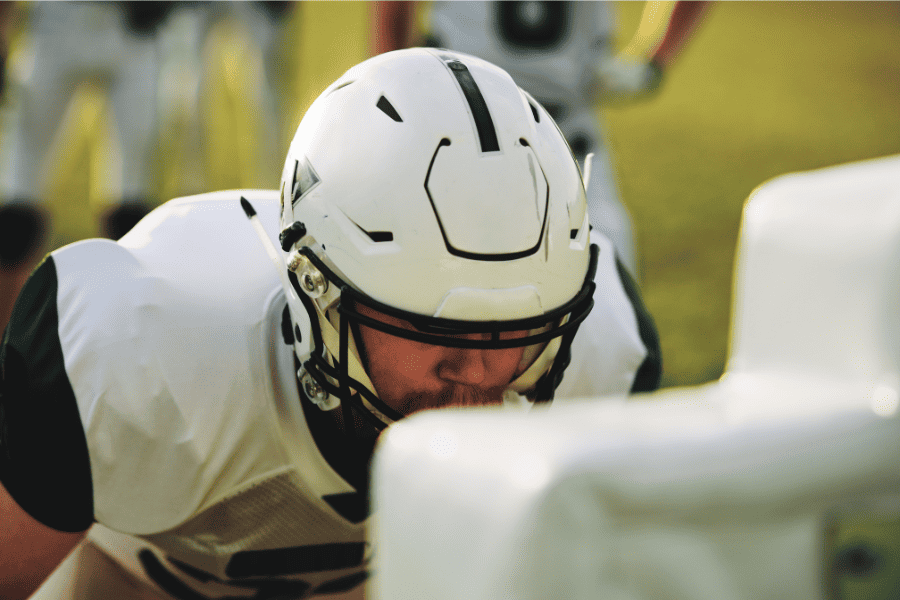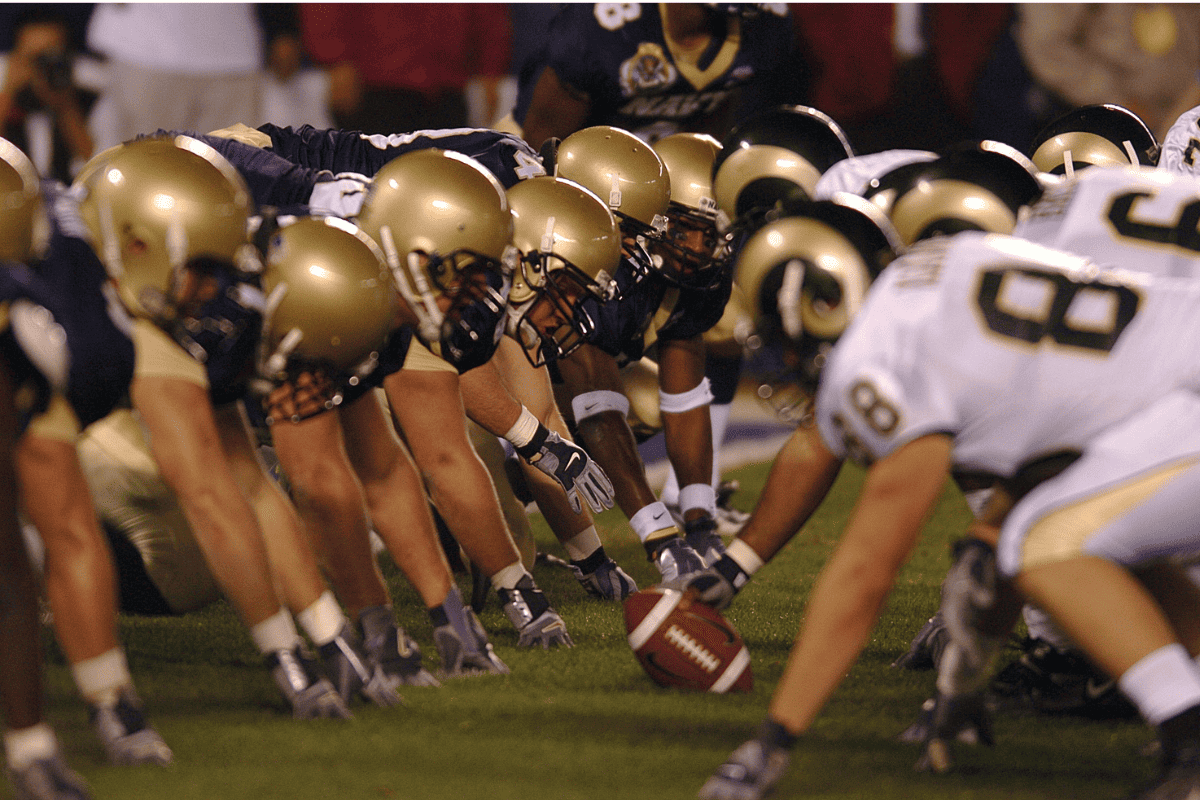What Does a Defensive Tackle Do in Football?
At the heart of the defensive unit in football lie the defensive tackles (DTs), the unsung heroes who often work tirelessly in the trenches. They usually line up in the center of the defensive line and are primarily responsible for preventing running plays in the middle of the line and for pressuring the quarterback on passing plays.
Their role is as grueling as it is critical, demanding not just physical strength and agility, but also a deep understanding of game tactics and the opponent’s offensive plays.
In the following sections, we will explain the roles, responsibilities, and skills of a defensive tackle, helping to shine a light on this often overlooked, but vital position.
Understanding the Position of Defensive Tackle
The defensive tackle position is the centerpiece of the defensive line in American football, lining up near the ball before the snap. As part of the front seven (four defensive linemen and three linebackers in a 4-3 defense or three defensive linemen and four linebackers in a 3-4 defense), their primary responsibility is to disrupt the offensive play.
They do this by trying to break through the offensive line, stopping running backs in their tracks, and applying pressure on the quarterback on passing plays. It is a demanding role that requires a combination of strength, size, agility, and a deep understanding of the opponent’s offensive game plan.
Variations in the Role Depending on the Formation (4-3 vs 3-4)
The specific role and responsibilities of a defensive tackle can vary depending on the defensive scheme employed by the team.
In a 4-3 defense, the team will typically employ two defensive tackles. One is responsible for ‘plugging’ gaps to stop running plays (the ‘1-technique’ DT or nose tackle), while the other is responsible for penetrating the offensive line to disrupt plays in the backfield (the ‘3-technique’ DT).
In a 3-4 defense, the team typically employs a (typically larger) lone nose tackle. This player lines up directly across from the offensive center and is responsible for controlling two gaps in the offensive line. They require extraordinary strength to stand up to double teams from offensive linemen and maintain their ground.
Each of these roles is critical in the defensive strategy, and the players chosen for these positions need not only the physical attributes required for the job but also the mental toughness and tactical understanding to execute their roles effectively.
Roles and Responsibilities of a Defensive Tackle

Stopping the Run: Gap Control and Responsibilities
The primary responsibility of defensive tackles in run defense is gap control.
In football terminology, a “gap” is the space between offensive linemen. Each defensive player is assigned one or more gaps that they must control and prevent the opposing team’s running back from getting through.
In a 4-3 defense, the one-technique tackle is primarily responsible for the A-gap (the gap on either side of the center), and the three-technique tackle is primarily responsible for the B-gap (the gap between the offensive guard and the tackle).
In a 3-4 defense, the nose tackle often has responsibility for both A-gaps.
Defensive tackles must be strong and powerful to stand up to the offensive linemen trying to push them out of the way, and they must also be quick and agile enough to adjust their position to tackle the running back if he comes through their gap.
Role in Pass Rush: Pressure on the Quarterback
When the opposing team decides to pass, the defensive tackle’s job changes. Now, instead of trying to control gaps and stop the run, they must try to push through the offensive line and put pressure on the quarterback.
The goal is to either sack the quarterback (tackle him behind the line of scrimmage before he can throw the ball), or at the very least hurry his throw and force him into making a mistake. This requires a combination of strength to defeat the blockers and speed to chase down the quarterback.
Importance in the Line of Scrimmage: Maintaining Control and Balance
Beyond their specific responsibilities in run defense and pass rushing, defensive tackles play a crucial role in controlling the line of scrimmage. The line of scrimmage is the imaginary line that separates the offensive and defensive teams before a play begins, and controlling it is vital to the success of the defense.
Defensive tackles must maintain their ground against the offensive linemen’s blocks and prevent them from advancing down the field.
If the offensive linemen can push the defensive tackles back and control the line of scrimmage, they can open up running lanes for the running back or give the quarterback plenty of time to throw the ball.
Conversely, if the defensive tackles can push the offensive linemen back and control the line of scrimmage themselves, they can disrupt running plays and put pressure on the quarterback, making it harder for the offense to gain yards and score points.
Key Skills Required for a Defensive Tackle

Physical Attributes: Size, Strength, and Speed
Defensive tackles are often among the largest players on the field. Their size gives them the mass they need to hold their ground against offensive linemen who are trying to push them out of the way.
However, size alone is not enough. They also need to have tremendous strength, particularly in their lower body, to drive against offensive linemen and push them back.
While size and strength are crucial, speed is equally as important.
Defensive tackles need to be quick off the snap, beating their opponents to the punch. They also need enough speed to pursue running backs and quarterbacks when they break through the line or out of the pocket.
Tactical Skills: Football IQ, Reaction Time, and Decision Making
Beyond their physical attributes, defensive tackles must also have a solid understanding of the game’s tactics. They need to understand offensive plays and formations to anticipate where the ball is likely to go.
This understanding allows them to react quickly when the ball is snapped and make the right decision on whether to try to control their gap, rush the quarterback, or something else.
A quick reaction time is vital as it can be the difference between a successful play and a missed opportunity.
Likewise, good decision-making skills are essential. Defensive tackles have to make split-second decisions about where to move, when to engage an offensive lineman, when to shed a block, and when to pursue a ball carrier.
Technical Skills: Tackling Technique, Leverage, and Hand Usage

Technical skills are another crucial aspect of a defensive tackle’s game. They must master proper tackling technique to bring down ball carriers effectively and safely. A good defensive tackle is one that not only brings down the ball carrier but also minimizes the risk of injury to both players.
Leverage is also a critical part of a defensive tackle’s game. They need to stay low to maintain their balance and gain an advantage over their opponents. The low man usually wins in the trenches.
Finally, hand usage is a key skill for a defensive tackle. They need to use their hands to control offensive linemen, shed blocks, and reach for ball carriers. Good hand usage can help a defensive tackle defeat an offensive lineman’s block and disrupt a play, even if the offensive lineman is bigger or stronger.
Famous Defensive Tackles in History
Here are just a few of the best defensive tackles in NFL history.
- “Mean” Joe Greene: A cornerstone of the Pittsburgh Steelers’ “Steel Curtain” defense in the 1970s, Greene was a ten-time Pro Bowl selection and two-time NFL Defensive Player of the Year. His combination of strength, speed, and aggressive play made him one of the most dominant defensive tackles in history.
- Warren Sapp: A key player in the Tampa Bay Buccaneers’ “Tampa 2” defense, Sapp’s quickness and agility made him a terror for opposing offenses. He was selected to seven Pro Bowls and won the NFL Defensive Player of the Year award in 1999.
- Reggie White: While White is more known as a defensive end, he also played as a defensive tackle and was incredibly successful in both positions. His combination of power, speed, and technique resulted in 198 career sacks, the second-most in NFL history.
- Alan Page: As a member of the Minnesota Vikings’ “Purple People Eaters” defense, Page was a dominant force at defensive tackle. He was a nine-time Pro Bowl selection and became the first defensive player to win the NFL’s Most Valuable Player award in 1971.
These players are prime examples of what it takes to be a great defensive tackle. Their physical attributes were evident: they had the size and strength to take on multiple blockers and the speed to disrupt plays in the backfield.
But it was their technical and tactical skills that set them apart. They understood the nuances of the game, often anticipating the opponent’s plays and reacting faster than anyone else on the field. Their hand usage and tackling technique were masterful, allowing them to shed blocks and bring down ball carriers effectively.
In many ways, these players redefined the role of the defensive tackle. Their performances demonstrated the importance of the position and highlighted the impact a dominant defensive tackle could have on a game.
By studying their careers, we can gain a deeper appreciation of the role of the defensive tackle position in football.
Final Thoughts
The defensive tackle is critical to a team’s defense, controlling the line of scrimmage, stopping the run, pressuring the quarterback, and disrupting offensive plans. Their combination of physical attributes, tactical insight, and technical skills makes them indispensable on the field.
To fully appreciate football, understanding each position’s roles is crucial, including the often overlooked defensive tackle. Acknowledging their importance helps us understand the strategic depth of football and appreciate it as a complex and intricate game.

